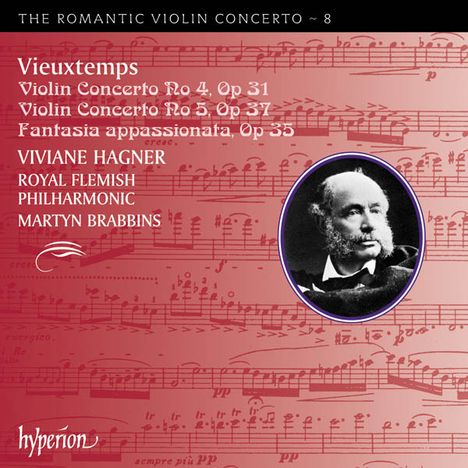Henri Vieuxtemps: Violinkonzerte Nr.4 & 5 auf CD
Violinkonzerte Nr.4 & 5
Herkömmliche CD, die mit allen CD-Playern und Computerlaufwerken, aber auch mit den meisten SACD- oder Multiplayern abspielbar ist.
Lassen Sie sich über unseren eCourier benachrichtigen, falls das Produkt bestellt werden kann.
+Fantasia appassionata op. 35
- Künstler:
- Viviane Hagner, Royal Flemish Philharmonic, Martyn Brabbins
- Label:
- Hyperion
- Aufnahmejahr ca.:
- 2009
- UPC/EAN:
- 0034571177984
- Erscheinungstermin:
- 1.5.2010
- Serie:
- The Romantic Violin Concerto
Im Mittelpunkt die Geige
In fast allen Werken von Henri Vieuxtemps spielt die Geige eine zentrale Rolle. Dennoch lag dem in Lüttich geborenen Komponisten und Geiger nicht daran, mit Virtuosität zu brillieren oder technische Finessen in den Vordergrund zu stellen. Sein viertes Violinkonzert wurde als »Sinfonie mit Solovioline« bezeichnet, da Violine und Orchester gleichberechtigt auftreten. Als Prüfungsstück für das Brüsseler Konservatorium komponierte Vieuxtemps sein Violinkonzert Nr. 5. Es wurde so erfolgreich, dass es sich im Repertoire gehalten hat und ist auch als »Grétry-Konzert« bekannt, da Vieuxtemps eine Melodie dieses Komponisten im langsamen Satz zitiert.
Product-Information:
Hyperion’s Romantic Violin Concerto series reaches volume 8 and the music of the Belgian composer Henry Vieuxtemps, himself widely considered the finest violinist in Europe after the death of Paganini. Listening to the repertoire recorded here, he certainly deserves to be ranked among the most important composers for the violin in the mid-nineteenth century. Vieuxtemps never indulged in sheer virtuosity for its own sake; instead in his concertos and chamber works he brought a more classical dimension to the violin repertoire in place of the technically brilliant variations and fantasies on popular operatic themes that were so popular with audiences.
The Violin Concerto No 4 in D minor, Op 31, which Vieuxtemps composed while he was court violinist in St Petersburg, is an heroic work on a substantial scale. It was described by Berlioz—who was perhaps comparing it with his own Harold in Italy for viola and orchestra—as a symphony with violin solo. In fact Vieuxtemps’s writing for the orchestra is as assured and resourceful, and sometimes as imaginative, as his treatment of the violin, though there is no doubt that the solo instrument remains the leading actor in the drama, reaching heights of stratospheric virtuosity throughout. Violin Concerto No 5 in A minor, Op 37, was written a few years later, in 1858–9, at the request of his friend Hubert Léonard, as the test-piece for a competition at the Brussels Conservatory. The work was, therefore, expressly designed to test the capabilities of (very advanced) student players, but it has maintained itself in the repertoire on its own merits and probably surpasses the Fourth Concerto in popularity. Fantasia appassionata, Op 35, was probably written shortly after the Fifth Violin Concerto, in 1860. Unlike the concertos this is more frankly a vehicle for transcendental technical display, but expertly cast in a single movement of several effectively contrasted sections that achieves a balanced form as well as the exhibition of the player’s prowess.
The young virtuoso Viviane Hagner, a former BBC New Generation artist, acclaimed for her highly intelligent musicality and passionate artistry, appears in her Hyperion debut.
Rezensionen
'The orchestra is beautifully balanced and recorded, Martyn Brabbins's direction is alert to Vieuxtemps's delicate romanticism as well as his grand theatrical gestures, and Viviane Hagner … is a most resourceful and spirited advocate … Occasionally, too, her account is techincally superior, for instance in the hair-raising, slithering diminished-seventh chords in No 4's finale' (Gramophone)
[A major Concerto] 'Munich-born virtuoso Viviane Hagner (rec. 8-10 July 2009) brings a splendid sense of the romantic style to this work, playing a 1717 Sasserno Stradivarius of sweetly brilliant tone. The performance becomes quite fiery and flamboyant, Hagner’s trills and runs striking a wonderful balance between poetry--in the C Major second subject--and ensuing fireworks. The extended cadenza employs double stops and polyphony to advance the themes of the first movement, soon to modulate into the Adagio and Allegro con fuoco finale, a relatively effusive coda than any sort of independent movement, but tailor made for the high-minded virtuosity Hagner projects, much in the Heifetz mold' (Audiophile Audition, USA)
Rezensionen
FonoForum 11/10: "Viviane Hagner gibt mit Vieuxtemps ihr Debüt bei Hyperion, das man als sehr gelungen bezeichnen darf. Gerade angesichts der gewichtigen Konkurrenz erscheint Hagners geigerische und musikalische Leistung bewundernswert, alles was manuell schwierig ist, etwa die Doppelgriffe und Staccati, hat sie "drauf", und so kann sie sich ganz der Gestaltung widmen. Da gibt es keine Passage, die gebremst klingt, bei Viviane Hagner hat man immer ein gutes Gefühl und kann die Musik genießen, zu der untrennbar die geigerische Bravour gehört."Disk 1 von 1 (CD)
Violinkonzerte / Konzerte für Violine und Orchester Nr. 5 (op. 37 a-moll, Grétry)
-
1 1. Satz: Allegro non troppo
-
2 2. Satz: Cadenza
-
3 3. Satz: Adagio - Allegro con fuoco
Violinkonzerte / Konzerte für Violine und Orchester Nr. 4 (op. 31 d-moll)
-
4 1. Satz: Andante - Moderato - Cadenza
-
5 2. Satz: Adagio religioso
-
6 3. Satz: Scherzo: Vivace - Trio: meno mosso - Vivace da capo
-
7 4. Satz: Finale marziale: Andante - Allegro
-
8 Konzertstück op. 35 (Fantasia appassionata für Violine und Orchester (Klavier))







